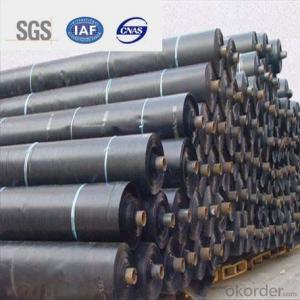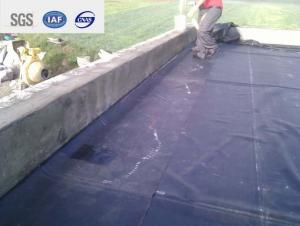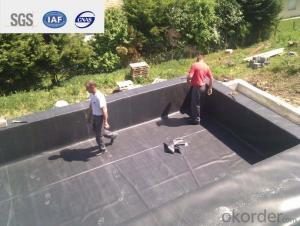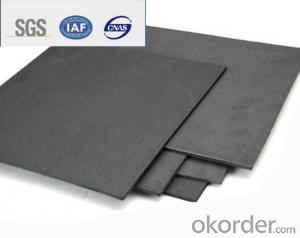EPDM Waterproofing Roofing Membrane for Roof 1.2mm and 1.5mm
- Loading Port:
- Qingdao
- Payment Terms:
- TT or LC
- Min Order Qty:
- 2000 m²
- Supply Capability:
- 800000 m²/month
OKorder Service Pledge
OKorder Financial Service
You Might Also Like
Description Of EPDM Rubber Waterproof Membrane:
1.EPDM Waterproof Membrane / Roofing Material / Sheets Roofing
2.High tensile strength.
3.Good elongation.
4.UV resistant.
5.Anti-corrosion.
Main Features of EPDM Rubber Waterproof Membrane:
1) Excellent weather-ability, durability and size stability
2) Good adaptability to high and low temperature, UV resistant and anti-corrosion
3) High tensile strength and good elongation, accommodating to structure movement
4) Easy installation, solid joint, and no environmental pollution
5) Good rooting penetration resistance
6) Service life up to 50 years
Specifications of EPDM Rubber Waterproof Membrane:
Material | EPDM Rubber |
Size | 1.2m (width)*20m (length) or customized, weldable type 2.05m or 4m width |
Thick | 1.2mm, 1.5mm, 2.0mm |
Type | Vulcanized & Weldable |
Pattern | Non-reinforced (homogeneous) |
Certificate | ISO9001/14001 |
Applications of EPDM Rubber Waterproof Membrane:
1) Roofs, Basement, Toilet
2) Industrial and civil building waterproofing
3) Geo-synthetic liner for swimming pool, channels, irrigation system
4) Especially suit for projects with high requirements in durability, anti-corrosion and deformation
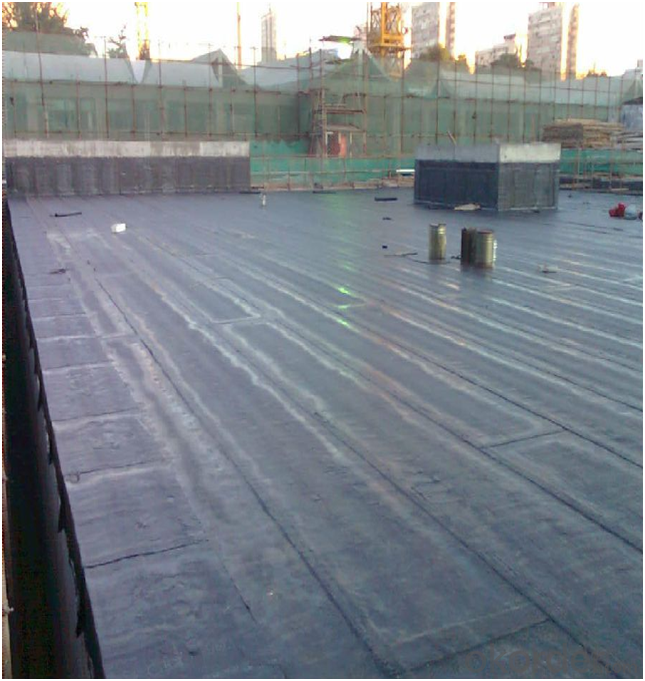


FAQ:
1. What are we supplying?
We are specialized in producing Colorful Asphalt Roof Shingle, SBS/APP modified bitumen waterproof membrane, Self adhesive bitumen waterproof membrane, PVC waterproofing membrane, EPDM rubber roofing membrane, Single Component Polyurethane Waterproof Coating, and Spray Polyurea Waterproof Coating.
2. How Many years experience do we have?
We have been exported to more than 20 countries in the past 15 years.
3. How long do we usually reply your request?
We always reply our customer within 24 hours.
- Q:Are there any limitations to using a waterproofing membrane?
- Yes, there are some limitations to using a waterproofing membrane. One limitation is that the membrane can be punctured or damaged during installation, which can compromise its effectiveness. Additionally, waterproofing membranes may not be suitable for all types of surfaces or structures, and certain conditions such as extreme temperatures or excessive movement can affect their performance. Moreover, the lifespan of a waterproofing membrane can vary depending on factors like maintenance, exposure to UV rays, and overall wear and tear.
- Q:Basement SBS Waterproof Coil Division I and II type What is the difference? How is the site identified?
- SBS type I and type II differences are mainly low temperature flexibility and tensile extension. Type I low temperature flexibility is -20 degrees, pulling force of 500N / 5cm, elongation of 30%. Type II low temperature is -25 degrees, tension of 800N / 5cm, elongation of 40%. The appearance of the general can not distinguish, you can do experiments.
- Q:Can a waterproofing membrane be used in elevator pits?
- Yes, a waterproofing membrane can be used in elevator pits. Elevator pits are vulnerable to water damage and moisture accumulation, so applying a waterproofing membrane can help prevent water intrusion and protect the elevator components from potential damage.
- Q:Can a waterproofing membrane be used on roofs with slope?
- Yes, a waterproofing membrane can be used on roofs with slope. In fact, it is often recommended to use a waterproofing membrane on sloped roofs to prevent water infiltration and to ensure proper drainage. The membrane is installed beneath the roofing material and acts as a barrier against moisture, helping to protect the roof and the underlying structure from water damage.
- Q:How does a waterproofing membrane handle differential settlement?
- A waterproofing membrane is designed to provide a barrier against water infiltration and protect the underlying structure from moisture damage. However, when it comes to handling differential settlement, the performance of the waterproofing membrane can be affected. Differential settlement refers to the uneven settling of the ground or the building foundation, which can lead to variations in the height or level of different parts of the structure. This can create stress and movement in the building, potentially affecting the waterproofing membrane. To address differential settlement, waterproofing membranes are typically designed to be flexible and able to accommodate minor movements without compromising their effectiveness. They are often made from materials such as modified bitumen, polyurethane, or rubberized asphalt, which have inherent elasticity and can stretch or contract to some extent. In cases of minor differential settlement, where the movement is within the tolerances of the membrane, it can adjust and remain intact, maintaining its waterproofing capabilities. However, if the settlement is significant or beyond the membrane's capacity to flex, it may cause the membrane to crack or tear, leading to potential water leakage. To mitigate the impact of differential settlement, additional measures may be taken during the installation of the waterproofing membrane. This could include incorporating stress relieving elements such as expansion joints or using specialized installation techniques that allow for movement. These measures help to distribute the stress caused by settlement and reduce the strain on the waterproofing membrane. It is important to note that while waterproofing membranes are designed to handle some level of differential settlement, they are not a solution for structural issues or significant settlement problems. In cases of severe settlement, it is crucial to address the underlying cause of the settlement and potentially involve a structural engineer to determine the appropriate remediation measures. In conclusion, a waterproofing membrane can handle differential settlement to a certain extent by being flexible and accommodating minor movements. However, it is essential to consider the severity of settlement and implement additional measures during installation to ensure the long-term effectiveness of the waterproofing system.
- Q:Can a waterproofing membrane be used on gypsum block surfaces?
- Yes, a waterproofing membrane can be used on gypsum block surfaces. Gypsum blocks are porous materials that can absorb moisture and are not naturally waterproof. Applying a waterproofing membrane can help to prevent water infiltration, moisture damage, and mold growth on the gypsum block surfaces. It creates a barrier that repels water and prevents it from seeping into the material. However, it is important to ensure that the waterproofing membrane is suitable for use on gypsum blocks and is compatible with the specific type of gypsum block being treated. Additionally, proper surface preparation and application techniques should be followed to ensure the effectiveness and longevity of the waterproofing membrane.
- Q:What are the requirements for frost resistance of basement floor polymer waterproofing membranes?
- High polymer modified asphalt waterproofing membrane is -30 degrees.
- Q:Can a waterproofing membrane be used for hospitals or healthcare facilities?
- Yes, a waterproofing membrane can be used for hospitals or healthcare facilities. Waterproofing membranes are commonly used in these types of buildings to protect the structure from moisture damage and prevent water leakage, which is crucial for maintaining a safe and hygienic environment. The waterproofing membrane helps to create a barrier against water infiltration, ensuring the longevity and integrity of the building and safeguarding the health and well-being of patients and staff.
- Q:Can a waterproofing membrane be used on EPDM roofs?
- Yes, a waterproofing membrane can be used on EPDM roofs. EPDM (ethylene propylene diene terpolymer) is a highly durable and flexible synthetic rubber roofing material commonly used for low-slope and flat roofs. While EPDM roofs are already waterproof, applying an additional waterproofing membrane can provide an extra layer of protection and enhance the roof's longevity. The waterproofing membrane can act as a barrier against water infiltration, preventing leaks and moisture damage. However, it is important to ensure that the waterproofing membrane is compatible with EPDM and follows the manufacturer's guidelines for installation to maintain the roof's integrity.
- Q:Can a waterproofing membrane be applied on a sloped surface?
- Yes, a waterproofing membrane can be applied on a sloped surface. In fact, applying a waterproofing membrane on a sloped surface can be even more critical than on a flat surface. Sloped surfaces tend to have more water runoff, which can increase the risk of water infiltration and damage to the underlying structure. By applying a waterproofing membrane on a sloped surface, it helps to create a barrier that prevents water from penetrating into the structure and directs it towards drainage systems. However, it is important to ensure that the membrane is properly installed and adhered to the slope to prevent any potential issues such as water pooling or membrane detachment. Additionally, the type of waterproofing membrane used should be suitable for sloped surfaces and have the necessary flexibility to accommodate any movements or shifting that may occur.
1. Manufacturer Overview |
|
|---|---|
| Location | |
| Year Established | |
| Annual Output Value | |
| Main Markets | |
| Company Certifications | |
2. Manufacturer Certificates |
|
|---|---|
| a) Certification Name | |
| Range | |
| Reference | |
| Validity Period | |
3. Manufacturer Capability |
|
|---|---|
| a)Trade Capacity | |
| Nearest Port | |
| Export Percentage | |
| No.of Employees in Trade Department | |
| Language Spoken: | |
| b)Factory Information | |
| Factory Size: | |
| No. of Production Lines | |
| Contract Manufacturing | |
| Product Price Range | |
Send your message to us
EPDM Waterproofing Roofing Membrane for Roof 1.2mm and 1.5mm
- Loading Port:
- Qingdao
- Payment Terms:
- TT or LC
- Min Order Qty:
- 2000 m²
- Supply Capability:
- 800000 m²/month
OKorder Service Pledge
OKorder Financial Service
Similar products
New products
Hot products
Hot Searches
Related keywords
